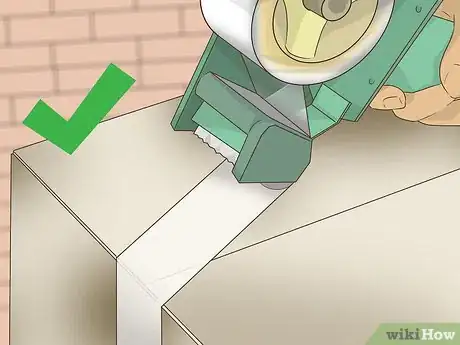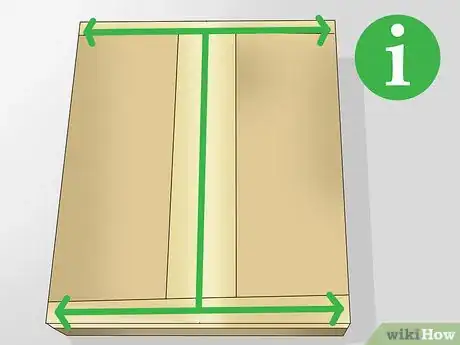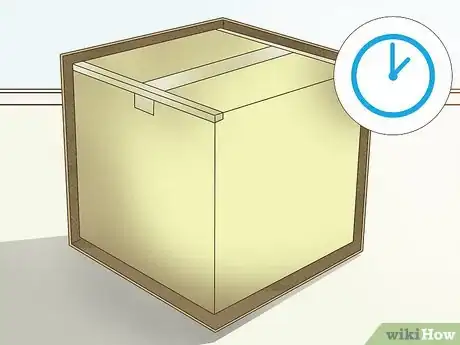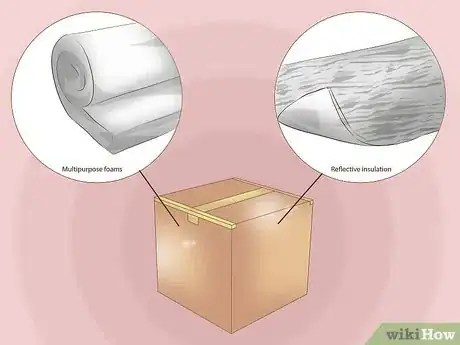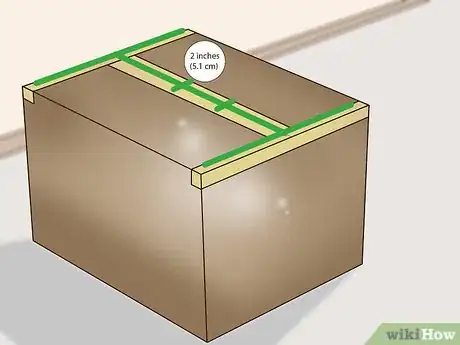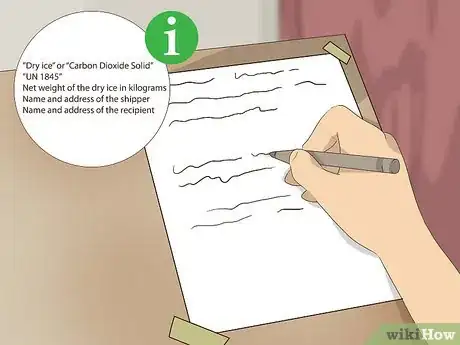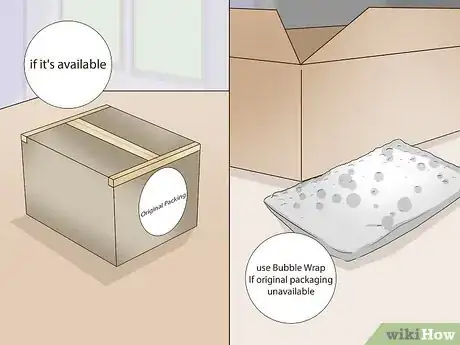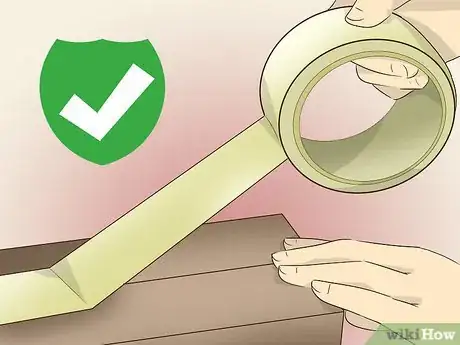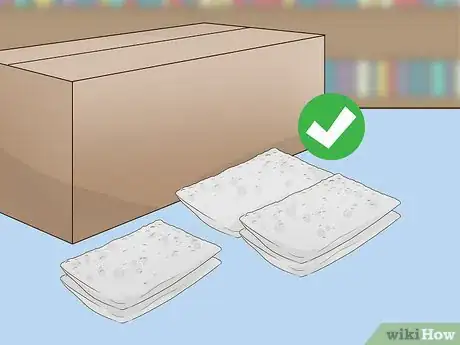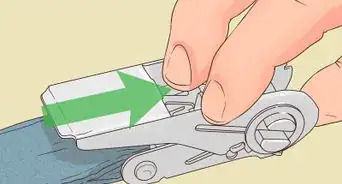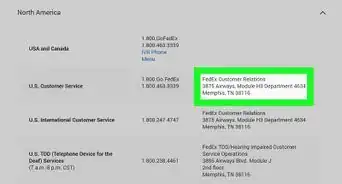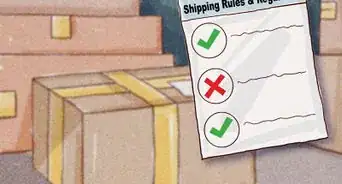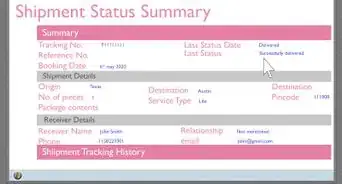This article was co-authored by wikiHow Staff. Our trained team of editors and researchers validate articles for accuracy and comprehensiveness. wikiHow's Content Management Team carefully monitors the work from our editorial staff to ensure that each article is backed by trusted research and meets our high quality standards.
This article has been viewed 36,813 times.
Learn more...
No one wants to open their package to find that it's been damaged in transit. Whether you're an e-commerce business or you're an individual sending a single package, there are a few easy steps you can take to make sure your shipment arrives safe and sound. It just takes some tape, the right sized box, and a little bit of diligence to ship an item without damaging it. Our how-to guide has plenty of packaging tips to help your item arrive without freight damage!
Steps
Packing General Goods
-
1Pick the right sized box. The ideal box should be a little bit bigger than your item, allowing a small amount of room for cushioning. Most shipping services accept using your own boxes, as long as the boxes are in good shape with little damage to the flaps. You can also purchase these directly from businesses, like FedEx or UPS.[1]
-
2Wrap items individually in cushioning material. If you're shipping multiple items, make sure to wrap them separately in Bubble Wrap, tissue paper, or old newspaper. This will prevent them from damaging each other in the package.[2]Advertisement
-
3Add material to fill any empty spaces. A key component of preventing shipping damage is eliminating as much space within the box as possible so your items cannot move around. While you can get creative with household items (such as towels, clothing, or old newspapers) as fillers, a few reliable methods are:
- Packing peanuts
- Bubble Wrap
- Tissue Paper
- Air-cellular material[3]
-
4Place smaller size boxes inside of larger ones. It's easy for packages smaller than 7 inches (18 cm) x 4 inches (10 cm) x 2 inches (5.1 cm) to get lost in the shipping process. Make sure to add some cushioning around the smaller box until it fills the larger one.[4]
-
5Seal the box with high-quality, pressure sensitive tape. For best results, you'll want to splurge on a sturdier tape that securely closes the box.[5] This kind of tape is available at Amazon or most office supply stores.
-
6Tape all flaps using the H taping method. Picture the top of your box as the letter, “H,” with each opening representing a part of the letter. Completely cover each seam with 2 inches (5.1 cm) wide tape. Never use string, rope, or twine in the shipping process to avoid damage.[6]
-
7Test your packaging by giving it a light shake. If you hear or feel any major shifting around, you'll want to open up the box to add more cushioning. You can also try dropping the package, but save this step for when you're more sure you did a solid job packaging your item!
Shipping Perishable Items
-
1Eliminate as much shipping time as possible. All shipping services offer an express shipment method. If you're shipping temperature sensitive material, it's best to spend extra in order to ensure that your package spends the least amount of time possible in transit. You can take steps to insulate your package, but no insulation method will hold up forever.[7]
-
2Place any frozen or items containing water into two bags. In case some of your product melts in transit, this will prevent any excess water from damaging the box. Make sure to use watertight bags to avoid any potential spills.[8]
-
3Put items in an insulated cooler. If possible, try to keep the cooler refrigerated until shipment. Prepare all insulation materials within this cooler.
-
4Insulate your items within the box. Similarly to adding cushioning to a standard shipment, you'll want to add specialty items to prevent the outside temperature from affecting your perishable items. A couple of the most common types are multipurpose foams and reflective insulation.[9] You can find these at Amazon, hardware stores, or on-site at most shipping services.
-
5Add refrigerants if your goods need to remain cold. Use gel coolants or dry ice to keep any items cold. Gel coolants are generally for refrigerated items, while dry ice will keep items frozen. Make sure not to use wet ice, as this will affect the weight of your package and can damage the box in transit.[10] Most grocery or hardware stores carry dry ice. If handling dry ice, remember to keep the following in mind:
- Wear eye protection, such as googles.
- Use tongs if possible.
- Wear loose-fitting, insulated gloves.[11]
-
6Place cooler inside shipping box slightly larger than the cooler. Add any necessary cushioning material to fill out the space between the cooler and the box.
-
7Tape all flaps using the H taping method. Cover all seams with 2 inches (5.1 cm) wide tape. For best results, use a pressure sensitive tape.[12]
-
8Mark the box as “perishable.” Write this in large and clear letters on all sides of your box. This will let the shipping service employees know to refrigerate your items if possible.[13] Include a manifest detailing the interior items as well in case your perishable items become separated from the box!
-
9Include an informational label if shipping dry ice. Since dry ice is technically considered a hazardous material, you are required to include information about the specifics on the outside of the box. Be sure to include:
- ”Dry ice” or “Carbon Dioxide Solid”
- ”UN 1845”
- Net weight of the dry ice in kilograms
- Name and address of the shipper
- Name and address of the recipient[14]
Packaging Fragile Items
-
1Use the original packing material if it's available. The company that produced the piece took caution to ensure that all pieces would arrive in tact when it was initially shipped, so their packing materials usually provide a snug fit.[15] If original packaging is unavailable, enclose each item separately in air-cellular material, such as Bubble Wrap.
-
2Wrap the fragile item in a plastic bag if using packing peanuts. Prevent any small pieces of styrofoam from getting inside the item by wrapping it in a plastic bag. It's entirely possible for small debris to damage the unit, especially if it's a computer piece.[16]
-
3Tape all packaging contents securely. Whether you used Bubble Wrap or the original packaging, you'll still want to heavily tape the item to enclose it. This will prevent any shifting around in transit.
-
4Package all accessory items separately. Wrap any extraneous items separately from the main item. Follow all above guidelines for these items as well, including placing them in separate plastic bags.[17]
-
5Get a box 6 by 6 inches (15 by 15 cm) larger than the packaged item. While the manufacturer's original packaging may fit well, it is not designed for reuse. This new box and extra space is for a hefty amount of cushioning. The added cushioning is also key if you're not using the original packaging.[18]
-
6Fill any excess space with packing peanuts. You should have at least 3 inches (7.6 cm) of space between your items and the box. Fill this space with loose leaf packing peanuts or another air-cellular material. Make sure the item is fitted and secure once the box is filled.[19]
-
7Tape the box using the H taping method. Tape all seams and flaps closed using 2 inches (5.1 cm) wide tape. Use pressure-sensitive tape if possible.
-
8Label the box as “fragile” on all sides. While this won't guarantee that they'll take extra caution while shipping your box, it will let them know that you took time to package your items carefully. Hopefully they'll do the same with your box!
Community Q&A
-
QuestionHow much cushioning should I use around shipped items?In general, more is always better. If you're not sure, add some more cushioning. If you can risk damage, you could test drop your package and see if it withstands the fall.
Warnings
- When shipping hazardous materials always use extra amounts of packaging materials and tape. Improperly packaged hazmats are a very real danger to the people taking care of your goods.⧼thumbs_response⧽
Things You'll Need
- A cardboard box
- Tape
- Styrofoam peanuts or other packaging materials
- Insulating or cooling materials
References
- ↑ http://images.fedex.com/us/services/pdf/How_To_Pack.pdf
- ↑ http://www.inboundlogistics.com/cms/article/preventing-shipment-damage/
- ↑ https://www.usps.com/ship/preparing-domestic-shipments.htm
- ↑ http://images.fedex.com/us/services/pdf/How_To_Pack.pdf
- ↑ http://www.inboundlogistics.com/cms/article/preventing-shipment-damage/
- ↑ https://www.usps.com/ship/preparing-domestic-shipments.htm
- ↑ http://images.fedex.com/us/services/pdf/How_To_Pack.pdf
- ↑ http://images.fedex.com/us/services/pdf/How_To_Pack.pdf
- ↑ http://images.fedex.com/us/services/pdf/How_To_Pack.pdf
- ↑ http://images.fedex.com/us/services/pdf/How_To_Pack.pdf
- ↑ https://www.ehs.washington.edu/system/files/resources/dryice.pdf
- ↑ https://www.usps.com/ship/preparing-domestic-shipments.htm
- ↑ http://images.fedex.com/us/services/pdf/How_To_Pack.pdf
- ↑ http://images.fedex.com/us/services/pdf/How_To_Pack.pdf
- ↑ http://images.fedex.com/us/services/pdf/How_To_Pack.pdf
- ↑ http://images.fedex.com/us/services/pdf/How_To_Pack.pdf
- ↑ http://images.fedex.com/us/services/pdf/How_To_Pack.pdf
- ↑ http://images.fedex.com/us/services/pdf/How_To_Pack.pdf
- ↑ http://images.fedex.com/us/services/pdf/How_To_Pack.pdf




